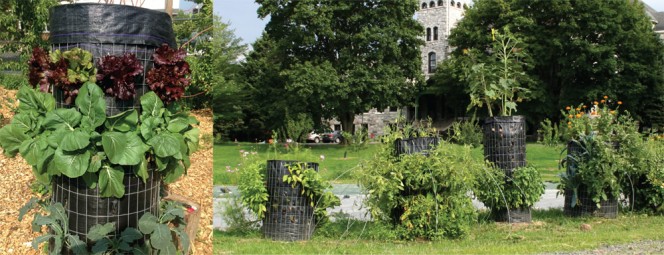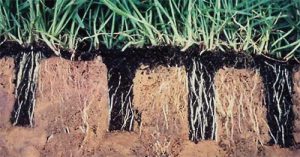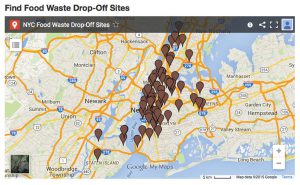BioCycle August 2015
New York, New York: Adding Food Scraps Drop-Off Sites
New York City (NYC) residents now have 64 NYC Department of Sanitation (DSNY) sponsored food scraps drop-off locations, located throughout all five boroughs. This drop-off program complements DSNY’s curbside NYC Organics Collection Program that is available to about 130,000 NYC households. All of the organic material accepted at these new drop-off sites will go to a local NYC Compost Project composting site (see “Community Composting In New York City” article series, starting in November 2013). The finished compost will be used by neighborhood greening groups, including urban farms, community gardens and street tree stewardship programs.
Kutztown, Pennsylvania: Vertical Gardening With Compost
Recent interest in food production in urban environments has prompted a reevaluation of soil safety, economic incentives, and the best practices for growing produce in Pennsylvania’s cities. City officials in both Philadelphia and Allentown are seeking options for minimizing the risks associated with soil contamination while at the same time increasing food production. In response, the Rodale Institute in Kutztown has proposed to demonstrate alternative vertical gardening technologies and the use of “growing towers” for urban practitioners, especially where space is limited for raised beds and box plots.
 Rodale Institute was awarded a grant in 2014 from the USDA Natural Resources Conservation Service, Pennsylvania Conservation Innovation Grant program to demonstrate the use and effectiveness of growing towers in various urban settings at four locations in the cities of Philadelphia and Allentown; two additional sites are located in rural Kutztown as well. Welded wire is shaped into a column three to six feet tall with a diameter of two to three feet. The interior of the column is lined with woven black landscaping plastic and then back-filled with a 50:50 blend of compost and soil prepared at the Rodale Institute. Direct seeding may be accomplished in the top of the tower while fruits, vegetables, herbs and flowers are transplanted into the sides. If the underlying soil is suspected to be contaminated, additional fabric can be placed on the bottom of the tower, thereby separating the contaminated soil with clean back-fill. Once the structures have been built, no further handling or manipulation of the soil is needed.
Rodale Institute was awarded a grant in 2014 from the USDA Natural Resources Conservation Service, Pennsylvania Conservation Innovation Grant program to demonstrate the use and effectiveness of growing towers in various urban settings at four locations in the cities of Philadelphia and Allentown; two additional sites are located in rural Kutztown as well. Welded wire is shaped into a column three to six feet tall with a diameter of two to three feet. The interior of the column is lined with woven black landscaping plastic and then back-filled with a 50:50 blend of compost and soil prepared at the Rodale Institute. Direct seeding may be accomplished in the top of the tower while fruits, vegetables, herbs and flowers are transplanted into the sides. If the underlying soil is suspected to be contaminated, additional fabric can be placed on the bottom of the tower, thereby separating the contaminated soil with clean back-fill. Once the structures have been built, no further handling or manipulation of the soil is needed.
Vertical gardening is in its second season at Rodale Institute and project leaders have identified and addressed a few challenges and obstacles with the growing towers. The initial prototypes were lined with straw that required a significant amount of time and labor to construct and tended to dry out more quickly than those lined with black plastic. During drought conditions, which were experienced early this spring in southeastern Pennsylvania, all towers required frequent watering but providing water to the plants near the bottom was challenging. The solution was to install perforated PVC pipes into the middle of the tower, which allowed practitioners to fill the pipes with water for slow release, directed watering. Lastly, soil compaction and nutrient deficiency is likely to become an obstacle after two or three seasons; however, project leaders are examining different compost-amended media formulations and the use of compost teas and other organic fertilizers for adding plant nutrients and beneficial microbiology.
The Rodale Institute is preparing general fact sheets and instructions for building growing towers, which will be available for free to the public this winter. A detailed booklet with a cost analysis, harvest report, and planting recommendations will be released in Fall 2016.
Brussels, Belgium: Compost And Soil Methane Uptake
The European Commission’s e-newsletter, Science for Environmental Policy, published an abstract of a paper, “Unexpected stimulation of soil methane uptake as emergent property of agricultural soils following bio-based residue application,” published recently in Global Change Biology. The researchers evaluated the capacity of methanotrophic bacteria, which use methane as a source of carbon and energy, to uptake methane in aerated soils. “While methanotrophs within rice paddies have been studied extensively, those in well-aerated soils have received little attention, as they are assumed to have a low capacity for methane uptake,” notes the newsletter. “This study is the first to properly test this assumption.” The researchers measured methane uptake in two aerated soil types — sandy loam and clay — taken from two typical agricultural fields in the Netherlands. They applied organic conditioners to the soil, then measured the effect on methane uptake. Conditioners tested were sewage sludge, aquatic plant material, compost, wood material and compressed beet leaves, added at amounts typical of intensive agricultural practice. After being added to soil samples, the mixtures were incubated in a chamber for approximately two months. The researchers measured methane and carbon dioxide flows, as well as the rate at which methane was oxidized.
“Their analysis revealed a surprising finding: the addition of the soil conditioners contributed to increased methane uptake,” reports the newsletter. “The researchers suggest the conditioners had this effect by increasing the nutrients available in the soil by introducing new methanotrophs, both of which can stimulate methane oxidation (although the latter by a lesser extent).” They determined methane uptake rates at a range of methane concentrations using untreated agricultural soils, “which showed the ability to oxidize methane over a wide range of concentrations, from atmospheric levels to very high concentrations, but after treatment, methane consumption increased up to threefold higher than in the untreated soil. … Consistent in both soils, amendment with compost had the greatest effect, and was able to offset approximately 16 percent of net emitted carbon dioxide. Applying compost to agricultural soils could thus reduce the impact of carbon dioxide and methane emission — both of which are greenhouse gases.” The authors suggest that repeated application of compost could reduce the impact of greenhouse gas emissions.
One caveat was noted in Science for Environmental Policy: “It is important to note that this research was conducted in the laboratory. The researchers therefore recommend field-based studies, as well as investigations of the impact of the intervention on nitrous oxide emission, another major greenhouse gas.”
Newark, Delaware: A Preacher Of Compost Quality
Have you ever seen this picture? If so, then you’ve been taught by Dr. William (Bill) Mitchell. “Doc” Mitchell was a professor of Agronomy and Soil Science at the University of Delaware. He assisted the early East Coast biosolids composting operations (Philadelphia, Baltimore,  Washington, DC), as well as the first large-scale MSW composting facility in New Castle, Delaware. Doc Mitchell always preached product quality and customer education. He conducted practical field research on an ongoing basis and created an educational curriculum (and a game) to teach children about the importance of composting. He was a big supporter of the 4-H, Cooperative Extension and was the “father of no-till planting” in Delaware. I met him in 1984, after he “retired,” when he worked as a consultant in the waste management industry, promoting “compost manufacturing” as a waste management technique, as well as expanding the use of compost with his common-sense field research. He not only encouraged me to keep learning, but he also gave me confidence back in the early days, when selling compost was a much more difficult thing to do. It is with great sadness that I share that this true icon of the early days of the U.S. composting industry has passed on. — Ron Alexander, R. Alexander Associates, Inc.
Washington, DC), as well as the first large-scale MSW composting facility in New Castle, Delaware. Doc Mitchell always preached product quality and customer education. He conducted practical field research on an ongoing basis and created an educational curriculum (and a game) to teach children about the importance of composting. He was a big supporter of the 4-H, Cooperative Extension and was the “father of no-till planting” in Delaware. I met him in 1984, after he “retired,” when he worked as a consultant in the waste management industry, promoting “compost manufacturing” as a waste management technique, as well as expanding the use of compost with his common-sense field research. He not only encouraged me to keep learning, but he also gave me confidence back in the early days, when selling compost was a much more difficult thing to do. It is with great sadness that I share that this true icon of the early days of the U.S. composting industry has passed on. — Ron Alexander, R. Alexander Associates, Inc.














